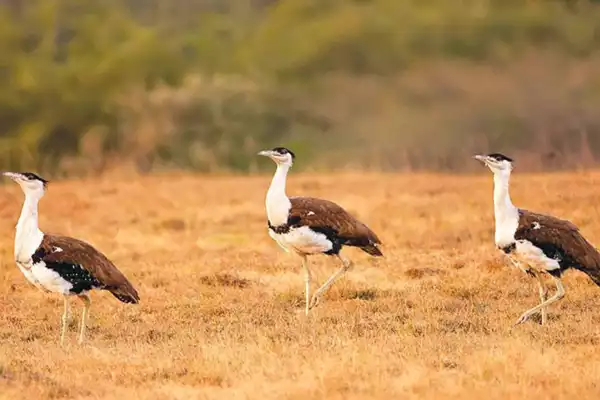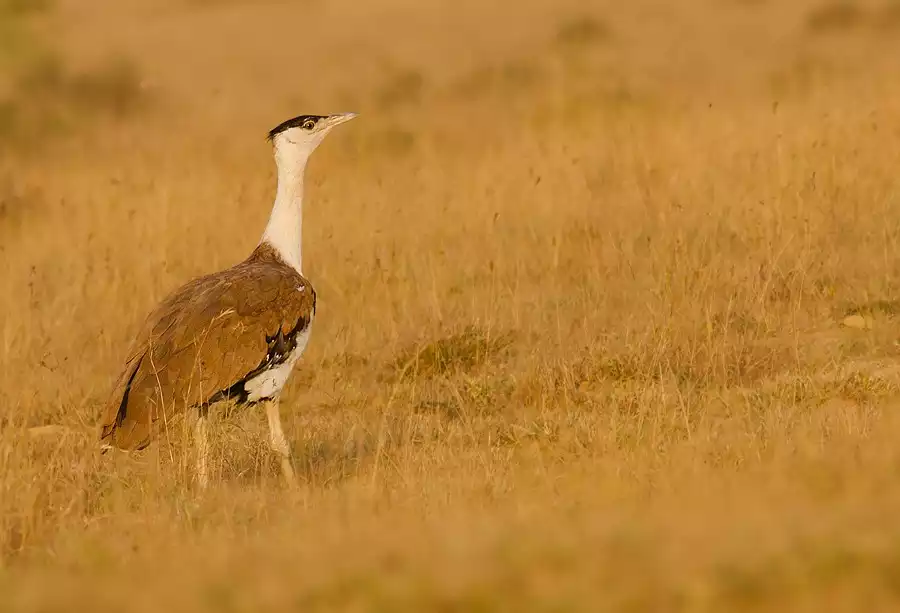The Great Indian Bustard (GIB), an iconic bird of the Indian grasslands, is facing critical endangerment in its habitats like the Rollapadu Wildlife Sanctuary in Andhra Pradesh.
About Great Indian Bustard (GIB):
- The GIB is a large bird that lives in dry grasslands and scrublands on the Indian subcontinent.
- It is one of the heaviest flying birds in the world, standing about one meter tall and weighing about 15 to 18 kilograms.
- They spend most of their time on the ground and only fly short distances between different areas.
- The GIB is often considered an indicator of the health of grasslands.
Habitat:
- Historically, the GIB’s stronghold was in the Thar desert in the north-west and the Deccan plateau of the peninsula.
- However, its current population is primarily concentrated in Rajasthan and Gujarat.
- It lives in arid and semi-arid grasslands, open country with thorn scrub, tall grass interspersed with cultivation.
- They prefer flat open landscapes with minimal visual obstruction and disturbance.
- It avoids irrigated areas.
- The major areas where it is known to breed are in central and western India and eastern Pakistan.
Characteristics:
- Its black crown on the forehead contrasting with the pale neck and head can easily distinguish the great Indian bustard.
- The body is brownish and the wings are marked with black, brown and grey.
Threats:
- Power Line Threats: Power lines pose a significant threat to GIBs due to their large size, limited frontal vision, and heavy flying nature, making them vulnerable to collisions.
- Habitat Loss: Dry grasslands, essential for GIBs, face habitat loss due to diversions for other purposes.
- Human Activities: The species has historically faced hunting and egg collection.
- Pesticide contamination, increasing populations of free-ranging dogs, pigs, and native predators add pressure on nests and chicks.
- Threat to Orans: Orans, natural habitats for the GIB, boast rich biodiversity and frequently feature water bodies.
- Unfortunately, the Orans in Rajasthan face a threat from green energy projects, particularly in the Thar desert, renowned for its high solar radiation.
- The Degrai Oran, situated in a 13,000 square kilometer biodiversity-rich area, represents one of the last natural habitats for the GIB.
Legal Protection:
- GIBs are listed in Schedule I of the Indian Wildlife (Protection) Act, 1972, Critically Endangered on the IUCN Red List & CITES Appendix I, enjoying the highest protection in India and globally.
The Indian government conservation efforts for the GIB:
- Project Bustard: Launched in 2012, this program protects the GIB, the Bengal florican, and the lesser florican, along with their habitats.
- GIB species recovery program: Launched in 2015, this program involves the WII and Rajasthan forest department setting up breeding centers to incubate GIB eggs.
- Project Great Indian Bustard: Launched in 2013 by the state of Rajasthan, this program identifies and fences off breeding grounds in protected areas, and provides secure breeding enclosures in other areas.
About Rollapadu Wildlife Sanctuary:
- Rollapadu Wildlife Sanctuary is a wildlife sanctuary in the Nandyal district of Andhra Pradesh.
- Known primarily as a habitat of the great Indian bustard, the species has suffered a drastic fall in its numbers in the sanctuary in recent years.
- It was established in 1988 to protect the great Indian bustard and the lesser florican and remains the only habitat in Andhra Pradesh for the bustard.
- The sanctuary is mostly an undulating plain with hot, dry climatic conditions and erratic and uneven rainfall.
Flora and Fauna:
- Rollapadu is primarily a grassland ecosystem with mixed forests and thorny bushes.
- Rollapadu sanctuary is home to a varied set of faunal and avifaunal species.
- Foxes, jackals, bonnet macaques, jungle cats, sloth bears and black bucks have been reported at the sanctuary as also the Russell’s viper and Indian cobra.
- An increase in the blackbuck population at the sanctuary has been postulated as one of the reasons for the fall in numbers of the bustard and the florican there.
- Their feeding on the grasses has in turn led to a fall in the numbers of grasshoppers and locusts that constitute an important source of food for the two bird species besides also reducing the nesting area available to these ground nesting birds.
Ref: Source
| UPSC IAS Preparation Resources | |
| Current Affairs Analysis | Topperspedia |
| GS Shots | Simply Explained |
| Daily Flash Cards | Daily Quiz |



